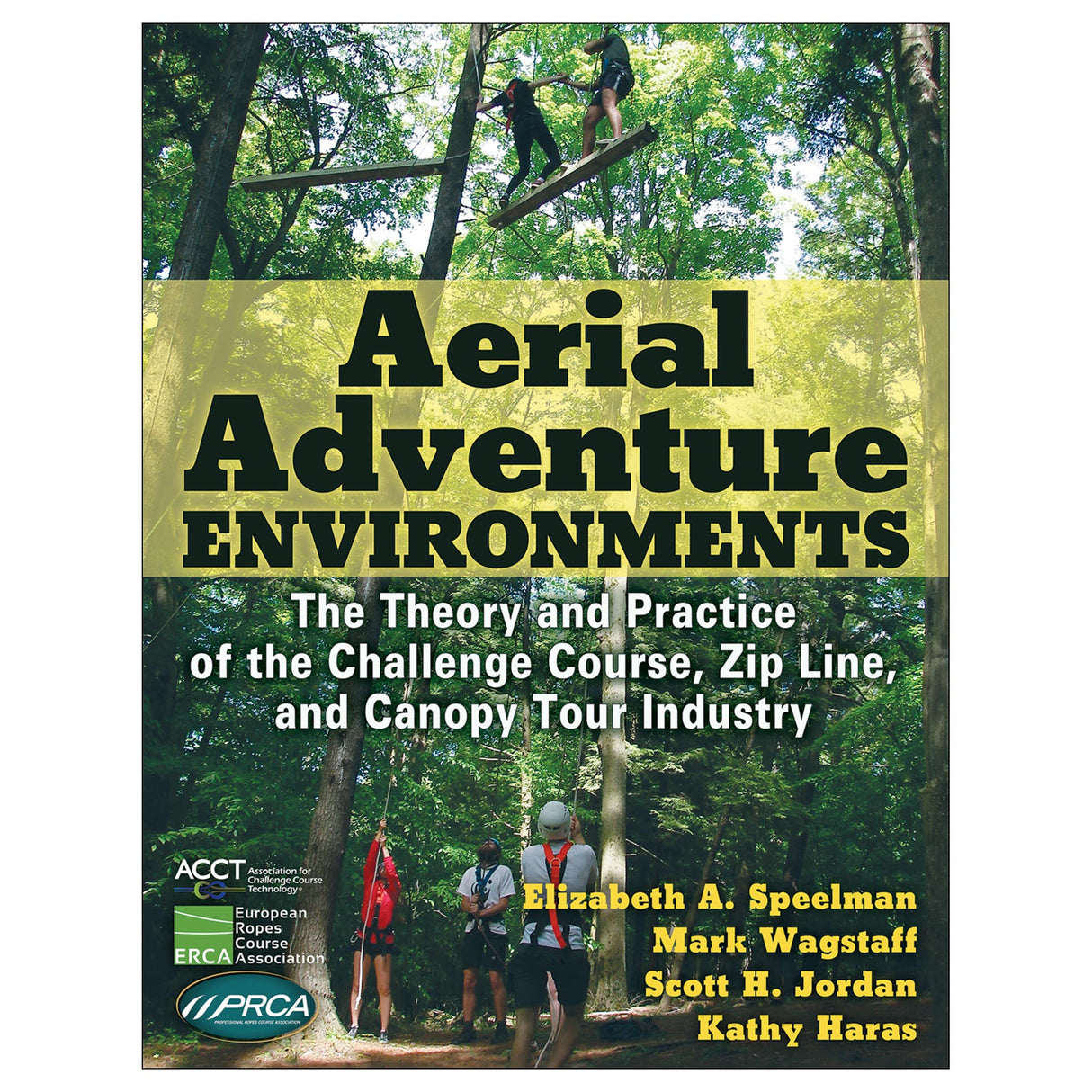Aerial Adventure Environments Ebook With HKPropel Access
The Theory and Practice of the Challenge Course, Zip Line, and Canopy Tour Industry
$77.95 CAD

Written by leading experts with both practical experience and theoretical knowledge in the field and endorsed by the Association for Challenge Course Technology (ACCT), the Professional Ropes Course Association (PRCA), and the European Ropes Course Association (ERCA), this complete resource contains the foundational information needed to understand the industry of aerial adventure environments. It provides practitioners with the tools they need to lead successful adventure experiences whether they are working directly with participants, designing and building structures, training staff, or conducting operational and marketing activities.
Readers will learn about the historical beginnings and global development of the industry, the theory and fundamentals behind aerial adventure programming, facility and equipment management, personnel training, and operational guidelines. The text presents practical information on understanding the desired outcomes of a variety of clients and how to design and deliver safe, effective, and inclusive adventure experiences with consideration for self-directed, guided, and facilitated experiences. The discussions of professional competencies and current industry issues and trends, as well as tips on how to obtain training, equip readers for success in the profession.
Chapter objectives, summaries, and review questions reinforce learning, and Putting It Into Practice elements illustrate practical applications of the content. Related online materials delivered via HKPropel include 21 checklists and forms that provide real-world value and include sample participant evaluation forms, job descriptions, challenge course questionnaires, program plans, and more. Special features throughout the book highlight four themes critical to the aerial adventure environment profession:
- Risk Management sidebars demonstrate how the management of risk must be embedded in every stage of the experience.
- Active Participatory Experience sidebars emphasize the hands-on nature of aerial adventures, whereby participants choose their level of challenge and their own adventures.
- Industry Standards sidebars cover best practices for subjects such as equipment selection, facility development, practitioner competencies, and management decisions.
- Social Justice and Human Diversity sidebars focus on the recent expansion of participants in aerial adventure experiences and the importance of inclusivity.
Note: A code for accessing HKPropel is included with this ebook.
Audience
Upper-undergraduate and graduate students in recreation courses, such as aerial adventure programming, team building leadership, ropes course facilitation, challenge course programming, and adventure education and facilitation. Also a reference for recreational professionals who lead adventure experiences.Chapter 1. Introduction to the Aerial Adventure Industry
What Is an Aerial Adventure Environment?
A Different Outdoor Industry
Aerial Adventure Professionals
Professional Associations
Summary
Review Questions
Chapter 2. History of Aerial Adventure Environments
A Common History
Development in the United States
Development in Canada
Development in Europe
Development in Japan
Development in Costa Rica
Facility Changes
Understanding What Was Happening
Summary
Review Questions
Chapter 3. Purpose of Aerial Adventure Environments
Goal Orientations
Organizational Alignment
Summary
Review Questions
Chapter 4. Fundamentals of Aerial Adventure Operating Systems
Low Activities
High Activities
Summary
Review Questions
Part II. Learning the Ropes
Chapter 5. Facility Design, Installation, Inspection, and Maintenance
Design
Installation
Inspection
Maintenance
Summary
Review Questions
Chapter 6. Equipment Systems
Equipment in AAEs
Systems Approach
Selection
Use
Care
Summary
Review Questions
Chapter 7. Personnel
Who Are the Personnel?
Understanding the Participant
Preparing Aerial Adventure Leaders
Summary
Review Questions
Chapter 8. Operations
Layers of Operational Guidelines
Nodes of Operational Management
Summary
Review Questions
Part III. Delivering the Experience
Chapter 9. Knowing Your Audience
Mead’s Stages of a Recreational Experience
Obtaining Participant Information
Risk Management and Legal Information
Providing Inclusive Programming
Summary
Review Questions
Chapter 10. Designing the Experience
Symbolic Interaction Theory
Program Outcomes
Understanding Domains for Participant Success
Sequencing
Program Plan
Summary
Review Questions
Chapter 11. Facilitating the Experience
Common Theory and Concepts of Facilitation
Facilitator Techniques
Summary
Review Questions
Chapter 12. Evaluation and Post-Experience Operations
Role of Evaluation
How Evaluation Is Done in AAEs
Levels of Evaluation
AAE Evaluation in Today’s World
Follow-Up
Summary
Review Questions
Part IV. Professional Preparation
Chapter 13. Professional Competencies
AAP Competencies
Summary
Review Questions
Chapter 14. Career Preparation
Career Development Model
Career Overview
Professional Preparation
Summary
Review Questions
Chapter 15. State of the Profession
Supporting Research
Current Issues
Summary
Review Questions
Participant evaluation of programs
Professional associations bring together like-minded professionals
What is an aerial adventure environment?
All ancillaries are free to adopting instructors through HKPropel.
Test package. Contains at least 20 questions per chapter in true-false, fill-in-the-blank, essay and short-answer, and multiple-choice formats. The files may be downloaded for integration with a learning management system or printed as paper-based tests. Instructors may also create their own customized quizzes or tests from the test bank questions to assign to students directly through HKPropel. Multiple-choice and true-false questions are automatically graded and student scores can be reviewed by instructors in the platform.
Instructors also receive access to all student materials in HKPropel. For Aerial Adventure Environments, this includes 21 downloadable checklists and forms from the book, including spotlights on various organization types, participant evaluation forms for zip line and challenge courses, job descriptions, facilitation log, challenge course questionnaires, staff skills evaluation form, program plans for varying outcomes, and precourse letter and interview questions. Also included are three unique documents consisting of a pre-use inspection form, a training plan worksheet, and an operations worksheet.





